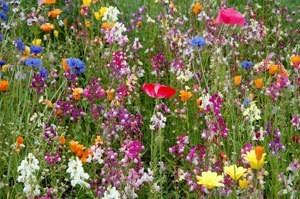
One of my first attempts at growing wildflowers consisted of buying a canister of Martha Stewart's Meadow Mix and peppering an area in my yard with seeds where I choose to let the grass go "native." I was certain a lovely meadow of wildflowers would spring forth and my landscape "au natural" would be the envy of all my neighbors. Instead, the results were a long way from spectacular and now, years later, I understand why.
Meadow wildflowers grow in meadows. A meadow is essentially a habitat made up of rolling hills or flat land where grasses predominate. By their very nature, meadows are able to maintain themselves in conditions that restrict the growth of woody plants. When we think of meadows, we often associate them with the farmland and prairies found in the Midwest and Western parts of the United States. But there are also alpine meadows, desert meadows and coastal meadows.
Meadow wildflowers considered native to the United States, are plants that grew here before settlers from Europe arrived with new species of flowers. As native wildflowers, they are perfectly adapted to their environment and resistant to insects, disease and severe changes in their environment such as droughts and fires. In addition to their beauty, they provide food and habitat for native wildlife.
Packets and shakers of wildflower seeds are now commonly offered alongside other garden seeds in many home stores and garden centers. If you've had some success with these store bought mixes, chances are it was short-lived (probably only the first season). The picture on the package is pretty, but the results usually are not.
One reason is that these seed mixes often contain a mixture of annual and perennial seeds from a variety of different growing zones-sometimes even from foreign countries! Many of the flower seeds are simply not naturalized to the part of the country they get planted in.
Most gardeners, myself included, are often under the false impression they can scatter their wildflower seed mixes among weedy fields and get attractive results. This doesn't work, because the weedy field is already established, leaving the new seeds unable to compete. Even when seeds are sown in a pre-tilled area, most of us are inclined to let nature take her course without performing additional cultivation practices.
A third reason wildflower mixes tend to disappoint is due to gardeners having unrealistic expectations. A wildflower display is seasonal. They are gorgeous during the blooming season, but can look rather messy once they have gone to seed.
The most important component of wildflower gardening is selecting the right mix of seeds for your growing zone. One way to do this is to visit a nursery that specializes in plants and flowers native to your area. Most will offer seed mixes as well as seedlings for transplanting-a good alternative if you're looking to establish your wildflower garden rapidly.
Consider what your yard has to offer and what you want the wildflowers to provide before deciding where to plant your wildflower garden. Wildflowers do well in an area which provides sun, rich soil, and adequate water. Do you have a limestone glade, a wet bog, open woods, or meadow? Will sunlight be available all day, part of the day, or not at all? Most wildflowers require six to eight hours of sun per day. Is the area low-lying where water will be available or is it in a dry spot? Choose flowers that will do well in the conditions you have available.
The size of the garden depends on your commitment to nurturing the plants until the ecosystem is created, so consider starting small. The soil should be cultivated and prepared in the same way you would prepare any other planting beds. Remove all plants and grasses before planting any wildflower seeds. This can be achieved by covering the area with dark plastic to discourage weed growth and tilling the soil to a depth of 12 to 18 inches.
Wildflower seeds can be mixed 8 to 1 with sand or coarse sawdust and broadcast over the desired area. If done in the fall, weeds will be less of a problem and winter will take care of the seeds that require chilling before germination. Annual mixes can be sown in the spring after danger of frost has passed, but the soil will need to be retiled and sown yearly to maintain the meadow. If you prefer, a roller will help to press the seeds into the soil. A light application of straw will preserve moisture and keep weeds down. Flowers will emerge in the spring. Further fertilization should not be necessary.
Watering, weeding, and yearly cutting of the meadow will be necessary to keep your wildflower garden looking good.

About The Author: Ellen Brown is our Green Living and Gardening Expert. Ellen Brown is an environmental writer and photographer and the owner of Sustainable Media, an environmental media company that specializes in helping businesses and organizations promote eco-friendly products and services.
Add your voice! Click below to comment. ThriftyFun is powered by your wisdom!